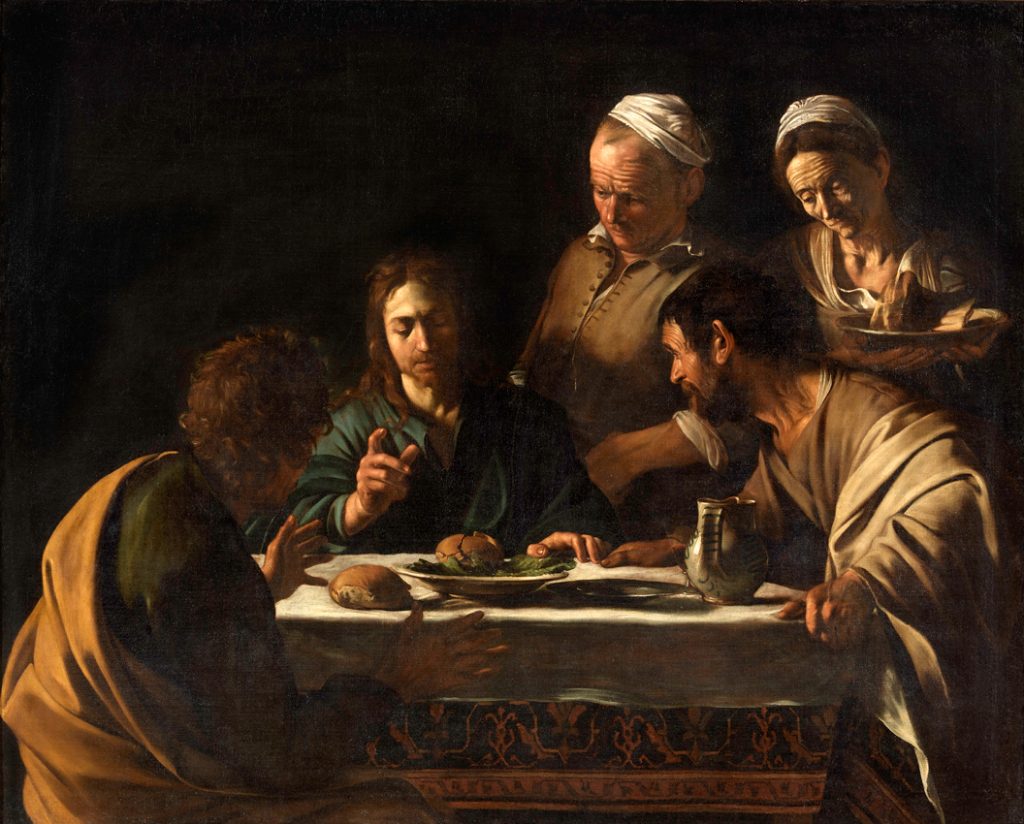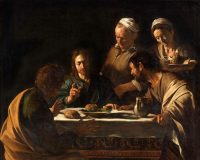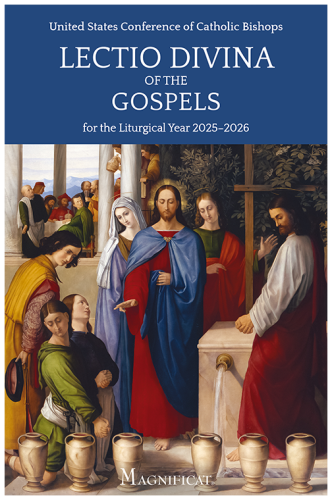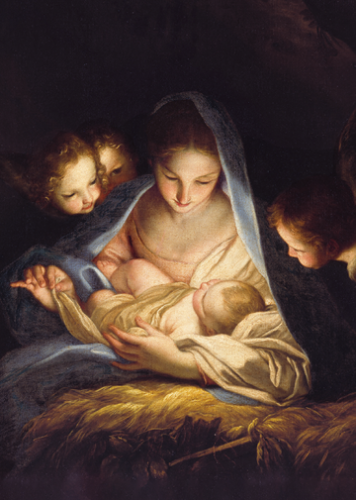The Supper at Emmaus (1606),
Michelangelo Merisi da Caravaggio.
The story of the road to Emmaus
The story of the road to Emmaus represents a key post-Resurrection appearance of our Lord. Two disciples are walking away from Jerusalem when an unknown man approaches them and explains the meaning of all that has recently happened, showing from the Scriptures why it was necessary that the Messiah should suffer these things and enter into his glory (Lk 24:26). The two disciples then beg the stranger to stay with them for supper, and it is during the meal that they recognize him as Jesus: And it happened that, while he was with them at table, he took bread, said the blessing, broke it, and gave it to them. With that their eyes were opened and they recognized him, but he vanished from their sight(Lk 24:30-31).
Why this moment?
The intimate and powerful moment of the Lord being known in the breaking of bread is the precise moment that Caravaggio (1571–1610) depicts in Supper at Emmaus, because it demonstrates to all believers where we are supposed to recognize our Lord today—in the Eucharist. Preaching on this story, Saint Augustine tells his congregation: “Ah yes, brothers and sisters, but where did the Lord wish to be recognized? In the breaking of bread. We’re all right, nothing to worry about; we break bread, and we recognize the Lord. It was for our sakes that he didn’t want to be recognized anywhere but there, because we weren’t going to see him in the flesh, and yet we were going to eat his flesh” (Sermon 235.3).
We do not have the disciples’ benefit of seeing Jesus in the flesh, of hearing his voice, of sitting down at a meal with him. But Christ ascended into heaven—vanished from our sight—to provide an experience of him that is just as intimate, and one available not only to those who live in Jerusalem but to those present at every altar in the world.
When coming to Caravaggio’s painting, then, we should be on the lookout for the meaning of the Eucharist. This work was painted in 1606, about seventy years after Protestant Reformers failed to come to an agreement about the meaning of the Eucharist at the Colloquy of Marburg. There, Ulrich Zwingli, founder of the Swiss Reformed Church, refused to renounce his purely symbolic understanding of the sacrament. Caravaggio is painting at a time when the meaning of the Eucharist is being hotly contested, both among Protestants and between Protestants and Catholics.
Supper at Emmaus
as Eucharistic meditation
This painting of the supper at Emmaus is quite a bit different from one Caravaggio had completed only five years earlier on the same subject. The earlier painting is more brightly lit; the disciples’ reactions are exaggerated, as is Jesus’ act of blessing the bread. The table is more crowded with food, and all the figures look younger. But in the 1606 version, Caravaggio has truly come into his own, and gives us a subtle yet emotive illustration of the moment of the Eucharistic sacrifice. Perhaps this turn to a more sober style reflects dark times in Caravaggio’s own life, namely his recent flight from Rome. The painter was wanted for murder and under threat of the death penalty—although the circumstances are not clear, Caravaggio lived a dissipated life. Suffering and an awareness of our mortality, however, have a way of bringing out our keenest religious sensibilities, even in such a wayward soul as Caravaggio.
The Eucharistic meaning of this painting, in other words, is not as blatant as in the earlier version, and yet we are drawn to it by its stark simplicity—and so it serves as an invitation to the doctrine of the True Presence rather than a forceful proclamation of it. First, we are beckoned to sit at the table with Jesus, at the very moment of the revelation of the risen Lord. In both versions of the painting, the side of the table facing the viewer has an empty place. Caravaggio is famous for his use of light and darkness, for extreme contrast, and for the accuracy of the shadows cast upon the characters’ faces. He uses light to draw our eye to the essential action. In this case, the only person facing entirely towards us is Jesus. His face is half in shadow, but being slowly illumined as the disciples come to recognize him. This hiddenness of Christ is also a wonderful encapsulation of our experience of Christ in the Eucharist—he is truly present, and yet he is veiled, partially in darkness. Jesus’ eyes are downcast as he looks at the bread he is blessing, the smallround loaf which is fractured in a like manner to the host, calling our attention to it. So also does the Lord continue to look down upon the bread at every Mass and bless it. The white yet ornate tablecloth evokes an altar covering.
In harmony with the rest of the scene, the reactions of the nearby people are understated but moving. The two disciples who now know whom they are looking at are tense with excitement and lean towards the Lord. But the two other bystanders are not unaffected, either. They may not yet recognize the Lord fully in the breaking of the bread, and yet they are drawn to him. The man standing behind Jesus looks at him with curiosity, his sun-weathered face somehow softened by the glow of the Lord’s presence. The woman who is serving does not yet raise her eyes to see Jesus, and yet she tilts her head reverently toward him, looking as if she is offering her weariness and suffering to the one sitting at the table. Here we have a picture of the whole crowd of those invited to the king’s wedding feast—those with hearts burning as they recognize the Lord, those coming slowly to see him, and those still waiting to draw closer to his presence.
Elizabeth Klein
Assistant professor of theology
at the Augustine Institute in Denver, Colorado.
The Supper at Emmaus (1606), Michelangelo Merisi da Caravaggio, Pinacoteca di Brera, Milan, Italy. © akg-images / Mondadori Portfolio / Mauro Magliani.













Additional art commentaries